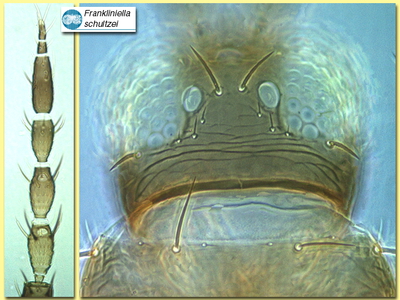Figures
Fig. 1 Antenna and head (dorsal)
Fig. 2 Fore and hind wing
Fig. 3 Pronotum
Fig. 4 Tergite VIII and IX (female)
Species
Frankliniella schultzei Trybom
Biology
A flower-living species with a wide host range, although sometimes displaying strong host associations locally; also known as a vector of tomato spotted wilt, and as a predator of plant feeding mites.
Distribution
Widespread in the tropics, but presumably originally from South America.
Recognition
Moderately large thrips, apparently existing as two distinct colour morphs that are possible genetically different and are sometimes considered to be distinct species. Commonly dark brown with brown antennae and pale forewings, but in tropical areas with the body yellow. Antennae 8-segmented, sense cones on III & IV forked. Head with one pair of setae in front of first ocellus, and one pair within ocellar triangle arising close together between anterior margins of posterior ocelli. Pronotum with 2 pairs of long setae on anterior margin, 2 pairs of long posteroangulars, and one pair posteromedially. Metanotum with median setae arising at anterior margin (or very close to it). Forewing with both longitudinal veins bearing complete row of setae. Tergites V-VIII each with a ctenidium laterally, on VIII anterolateral to spiracle; tergite VIII posterior margin without a comb of microtrichia. Sternites with no discal setae. Male sternites III-VII with transverse glandular area.
Related species
No other member of the genus is known to have the pair of setae within the ocellar triangle so close together.





